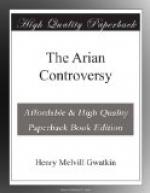[Sidenote: State of parties.]
The case of Antioch was not exceptional. Arians and Nicenes were still parties inside the church rather than distant sects. They still used the same prayers and the same hymns, still worshipped in the same buildings, still commemorated the same saints and martyrs, and still considered themselves members of the same church. The example of separation set by the Eustathians at Antioch and the Arians at Alexandria was not followed till a later stage of the controversy, when Diodorus and Flavian on one side, and the Anomoeans on the other, began to introduce their own peculiarities into the service. And if the bitterness of intestine strife was increased by a state of things which made every bishop a party nominee, there was some compensation in the free intercourse of parties afterwards separated by barriers of persecution. Nicenes and Arians in most places mingled freely long after Leontius was dead, and the Novatians of Constantinople threw open their churches to the victims of Macedonius in a way which drew his persecution on themselves, and was remembered in their favour even in the next century by liberal men like the historian Socrates.
CHAPTER V.
THE VICTORY OF ARIANISM.
[Sidenote: The West (337-350).]
Meanwhile new troubles were gathering in the West. While the Eastern churches were distracted with the crimes or wrongs of Marcellus and Athanasius, Europe remained at peace from the Atlantic to the frontier of Thrace. The western frontier of Constantius was also the western limit of the storm. Hitherto its distant echoes had been very faintly heard in Gaul and Spain; but now the time was come for Arianism to invade the tranquil obscurity of the West.
[Sidenote: Magnentian war, 350-353.]
Constans was not ill-disposed, and for some years ruled well and firmly. Afterwards—it may be that his health was bad—he lived in seclusion with his Frankish guards, and left his subjects to the oppression of unworthy favourites. Few regretted their weak master’s fate when the army of Gaul proclaimed Magnentius Augustus (January 350). But the memory of Constantine was still a power which could set up emperors and pull them down. The old general Vetranio at Sirmium received the purple from Constantine’s daughter, and Nepotianus claimed it at Rome as Constantine’s nephew. The Magnentian generals scattered the gladiators of Nepotianus, and disgraced their easy victory with slaughter and proscription. The ancient mother of the nations never forgave the intruder who had disturbed her queenly rest with civil war and filled her streets with bloodshed. Meantime Constantius came up from Syria, won over the legions of Illyricum, reduced Vetranio to a peaceful abdication, and pushed on with augmented forces towards the Julian Alps, there to decide the strife between Magnentius and the house of Constantine. Both parties tried the




